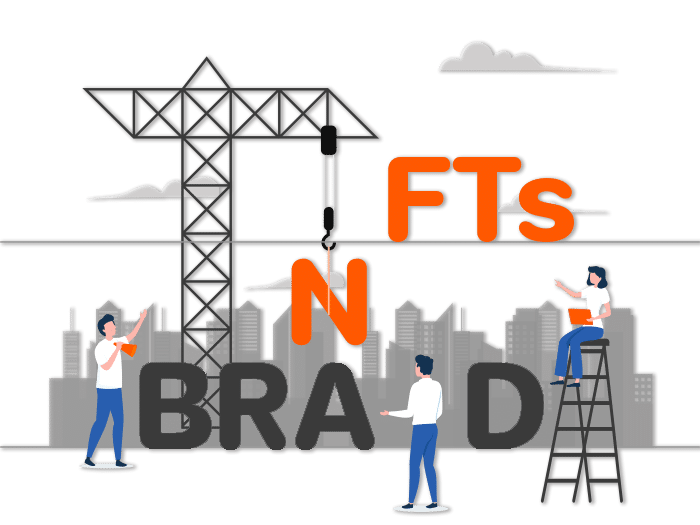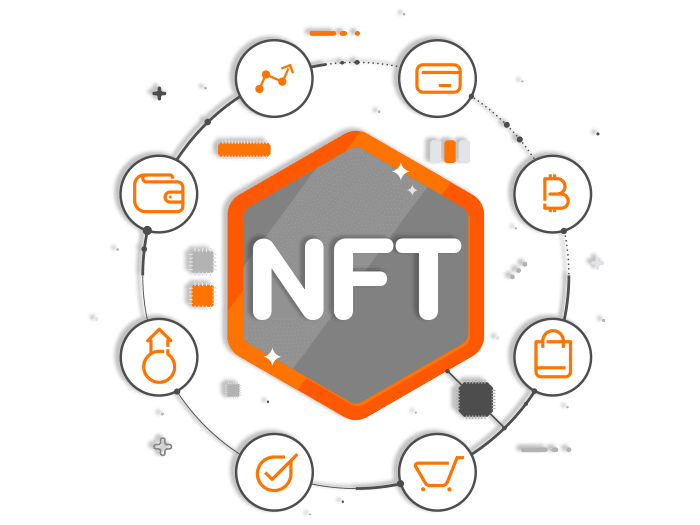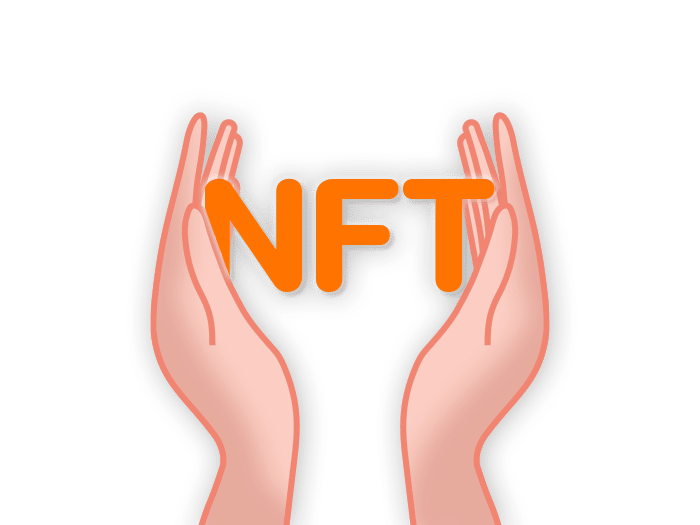
Regular readers of the news have most certainly come across the term NFT in recent weeks.
Non-Fungible Token was voted the year’s most commonly used phrase by Collins Dictionary, with an almost 11,000 percent increase in usage in 2021.
Given that NFTs completed $23 billion in transactions last year, the 2021 Dapp Industry Report reveals that firms want to understand how to get into this profitable market.
Businesses from all around the globe have entered the NFT competition in order to rethink their branding and broaden their market reach. Then, just what are NFTs and how do they work?
About NFT and Blockchain
Non-fungible tokens (NFTs) In the digital age, everything is represented by a digital token. Non-fungible objects, in other words, cannot be replaced.
Consider the art market: how many Van Goghs, excluding the Mona Lisa, are there worth? These two literary masterpieces have nothing in common.
Fungible notes can be traded for other sorts of currency, such as two $5 bills.
The blockchain system in cryptocurrencies such as Bitcoin keeps track of these unique and personalized electrical codes. On the blockchain, all transactions are recorded in an unalterable encrypted manner.
The one file associated with the digital asset is thereby connected to the blockchain’s single certificate, assuring its legality and ownership.” Assets such as artwork or collectibles may be registered using this digital certificate.
Anyone or any business may create an NFT by simply locating a firm that does so and paying a fee for the creation of these digital assets. Owners of NFTs can sell their assets on popular markets like as OpenSea and Rarible.
How are brands using them and what results are they getting from it?

NFTs rose to notoriety as a result of multimillion-dollar purchases for works of art such as Beeple’s The First 5000 Days, and celebrities joined the movement as members of an elite club. Neymar, Jimmy Fallon, Eminem, and Snoop Dogg paid millions of dollars for the Bored Ape Yacht Club.
Despite their widespread application, NFTs are a relatively recent technology. Businesses can choose from a number of options, including new behaviors and technological developments.
Following broad acceptance, businesses in a range of industries began to use NFTs.
So, what are some takeaways with regards to NFTs in the context of digital marketing?
Ownership is an important idea in NFTs since it strengthens the link between the brand and its customers. NFTs allow musicians to sell directly to their own audience rather than relying on streaming platforms.
JPEG, GIF, 3D animation, and virtual reality artwork are examples of NFTs. You may now provide virtual goods and services in addition to actual ones.
There are no citations.
Furthermore, the use of NFTs reduces the cost of shipping, product failure, and storage. As a result of your goals, they may be superior. Why not? Selling premium brands online is more important than selling actual products, so why not?
Are you interested in NFTs and blockchain technology? You may count on the help of our digital marketing experts!
How NFTs can turn consumers into brand advocates
Transform 2022 will be back in New York City from July 19 to July 28, both in person and online. Join artificial intelligence and data science experts for educational and networking opportunities. Don’t let this chance pass you by!
Virtual reality allows for shopping, conversing, and enjoying a cup of tea. It’s getting closer by the second. The notion of shared, interoperable, and immortal virtual worlds, known as the metaverse, has taken the real world by storm.
The metaverse, which includes advertising, digital events, and hardware, is expected to generate $1 trillion in income by 2025.
Companies including as Burberry, Coca-Cola, Gucci, Louis Vuitton, and Selfridges are among those rushing to join the metaverse utilizing non-fungible tokens (NFTs).
Non-fungible tokens (NFTs), which are unique digital assets that offer verified ownership of digital or physical items, are intrinsically tied to Metaverse and Web3 ideas.
Because to the emergence of NFT technology, businesses can now implement new marketing techniques that engage with customers on a deeper level. Embracing NFT benefits both existing clients and new groups and generations.
Coca-Cola, a hugely successful brand in the real world, is striving to build an online presence. Last year, Coca-Cola used the Decentraland avatar generator Tafi to generate its first NFT collectibles.
A Coke bubble jacket, a friendship card, and a bottle opener sound visualizer are included in the friendship NFT package. Along with increasing sales, the advertisement contributed with Special Olympics fundraising efforts.
Macy’s, like Coca-Cola, has dabbled in charitable digital collectibles. 9500 NFT artworks based on balloons from the parade’s nine-decade history were distributed to mark the parade’s 95th anniversary.
Furthermore, Macy’s donated 10 Ultra Rare NFTs to a charity auction benefiting the Make-A-Wish Foundation. The digital collectibles, on the other hand, were meant to donate 10% of their profits to Make-A-Wish.
Metaverse campaigns are more practical and cost-effective than traditional approaches such as NFT airdrops or one-of-a-kind collections such as the McLaren racing NFTs.
Because no real supplies, labor, or equipment are necessary, virtual clothing is significantly less expensive to produce than physical clothing. COVID-19 and other digital technologies might help businesses overcome distribution constraints.
Customers may assume they are receiving something for nothing by participating in NFT giveaway programs, which may help them create good relationships with firms. Freebies related with real-world items, such as avatars, event entrance, or discounts, are especially harmful.
In-game advertising may also include aspects from the metaverse and virtual gameplay settings. Advertisements may be seen everywhere, from online billboards to sporting events. Budgets for advertisers are no longer a limitation.
Commercials for well-known brands, for example, may be remade as interactive mini-games with NFT prizes for reaching certain levels.
Pokémon Go is a great example of product placement in virtual reality games, where the game’s animals were used to draw more people to a certain location.
Companies may use immersive advertising experiences to construct their own micro-metaverses. The NBA’s Cleveland Cavaliers have created a one-of-a-kind digital NFT experience for their supporters.
Only non-transferable products (NFTs), such as digital t-shirts and varsity jackets, are collectable on-site through “My Cav Locker.”
The event’s gamification improved spectators’ in-person engagement with NFTs and digital assets.
As a result of NFTs and the advent of a new metaverse, advertising will be redesigned. It’s tough to resist the excitement generated by the potential of this brand-new technology.
Those who arrive early in the metaverse will have an edge over those who come later.
What Consumers Have To Know About NFTs
When it comes to NFT fraud, both businesses and customers must be cautious, even if it appears to be a wise investment.
To begin, ensure that the person selling the token is the sole owner of it. According to Telos Foundation’s Head of Product Justin Giudici, a thief such as Gucci or Nike is not a huge concern.
CARLOS, MARCO “Before purchasing any NFT, be sure the person or brand you’re dealing with isn’t cheating you or selling assets they don’t own.
Because large corporations are now participating, it is easier for scammers to capitalize on people’s excitement.” The fact that some platforms lack proper verification methods exacerbates the problem.
Before investing in these new currencies, Akbar Hamid, CEO and inventor of 5CRYPTO by 5th Column, recommends that you educate yourself about the blockchain, potential investors, and how to construct a wallet.
When it comes to selecting an NFT business, Hammid points out that there are several possibilities.
How do big companies use NFTs?
Here are the examples on successful NFTs campaigns done by popular brands.
Nike
Profits from NFT have historically been made by sneaker lovers willing to pay exorbitant prices for a one-of-a-kind Nike shoe. Cryptokicks are digital reproductions of authentic shoes that you can buy and keep in your online locker once you’ve paid for them.
Despite the fact that these shoes are impractical in real life, you can put them on your characters in video games like Fortnite, giving you an unrivaled pair of shoes that will look wonderful on your characters.
Taco Bell
Yum Brands, the owner of fast-food eateries such as Taco Bell and Pizza Hut, relies heavily on unconventional financing. NFT gifs from the Mexican cuisine brand sold out in less than 30 minutes on the internet marketplace Rarible.
This campaign, in addition to earning revenue for a scholarship program affiliated with Taco Bell, highlights how valuable these tokens can be for businesses, with some fetching hundreds of dollars on the open market. Certain relics are being resold for more than $3,000 per piece.
Team GB’s NFTs for the 2021 Olympics
Despite the lack of international fans and supporters during the 2021 Olympics, important advances were achieved, such as Team GB’s launch of an NFT campaign.
Olympic gold medalists from Team GB were on hand to meet and greet fans and give unique experiences at a British Olympic Committee-organized NFT event.
The event was organized by the British Olympic Committee (BOC).
Despite the low ratings, this was a fantastic endeavor to honor sportsmen while simultaneously earning funds for the British Olympic Association.
Ubisoft
As can be seen, NFTs are a very useful resource in video games. Ubisoft created an Ethereum-based Rabbids game in which fans may buy characters from the famous game.
This game, however, has a twist in that a player can lose his or her whole collection of Rabbids at any time. UNICEF advertising is among these, a charity that has increased in favor among firms that utilize NFTs.
“We wanted to do something unusual and unexpected, and we wanted to experiment with developing our own NFTs to see how far we could push the programmable element of things,” says Nicolas Pouard, Ubisoft’s blockchain editorial director.
Coca-Cola
Some of Coca-assets Cola’s were brought to life in the virtual world for International Friendship Day. All of this was done to commemorate the event.
This collection comprised a decentralized 3D virtual reality platform, as well as future Coca-Cola delivery jackets that customers would be able to wear on Central.
Special Olympics International, the world’s foremost sports organization for people with intellectual disabilities, received a portion of the proceeds. The full amount raised was given to this organization.
Vodafone
In 2019, Vodafone developed an augmented reality game for an Apple promotional prize that required players to identify Vatoms, which are non-ferrous metals (NFT).
Following the success of the first edition, the second edition began in 2020 in collaboration with Samsung to provide participants with thousands of dollars in technology rewards related to NFTs.
The Future of NFTs
Despite the fact that NFTs are still in their infancy, there are a few practical applications that may be applied right away. Individuals in the latter type are prepared to part with their money out of appreciation for them.
These are unambiguous indications that they plan to keep their positions of power. We may expect to see considerable growth in the use of NFTs and the blockchain technology that enables them in the near future.
There are new ways to communicate with your audience and provide them with unique experiences as a result of the emergence of non-fungible tokens. Remember that many of the technologies we now take for granted (such as social media) were once considered fads.
While this is true, we rely on them heavily in our everyday lives. While these next-generation thin films (or “NFTs”) may appear to be a passing craze, they provide several advantages over current technology, including improved transparency and security.
There are a lot of going on with the NFTs. And it is only the beginning.
Verdict
You may have a long-term influence on your customers if you use NFTs. You may also use them to connect with and communicate with your target audience. Marketers must keep a careful eye on this technology because it is still in its infancy.
You should think about including unconventional marketing strategies in your strategy. Creating limited editions of your goods, creating one-of-a-kind advertising campaigns, and cooperating with NFT artists are all options.
NFT is undeniably here to stay and will continue to play an important part in digital marketing in the future.